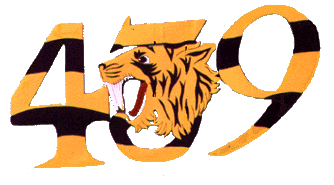|
History
of
 Squadron Squadron
  
Chapter
VI
Winter in the Netherlands
November 1944 January
1945
December opened with another experiment in "vector" or blind bombing. The idea was for the aircraft to fly at a specified height, speed and course while G.C.C. (Group Control Centre) plotted their movement by radar, gave the necessary changes of course ("vectors") to bring them over the target, and at the right moment told them to
release their bombs.
No. 439's first experiment was carried out by F/L Crosby, F/O Anderson, F/L Carr and F/O McBride on the
afternoon of 1 December. "Cosy Cot" directed them to climb to 9000 feet and, after levelling out, maintain a steady 260 m.p.h. Several changes of course brought them over the target, a small town east of
Roermond, where at the instruction of control the bombs were
released into the clouds. The pilots, of course, could see no results, but technically at least the demonstration was a success.
(1) The new policy was for aircraft on weather recces to carry bombs in case a
"target of opportunity" presented itself.
|
Intentionally
left blank
|
Intentionally
left blank
|
The 3rd, to everyone's surprise, dawned bright and sunny after a day of heavy rain and the squadron was able to get in 27 sorties on four operations before the sky again clouded over at midday. An early morning weather recce led by
"Bing" Crosby started the day's proceedings by dive bombing a train on the line between Haltern and
Dulmen. One pair of bombs made a direct hit on the engine, "blowing it up
completely". others cut the rails. Later in the
morning "Bing" led another recce which cut the line in two places between Dorsten and Haltern (but missed an engine on the track), and then strafed a train on the Ahaus Coesfeld line , damaging the locomotive and many cars.
Two regular dive bombing missions were equally successful. One formation led by Johnny Carr blew a gap in the tracks south of
Coesfeld, damaged two stationary trains, destroyed another locomotive and riddled the cars it was pulling. While this was going on, two Me.262 jets sneaked in unseen and made a diving attack on the two fighter cover Typhoons. A quick turn to starboard evaded the bursts which the Huns fired before they climbed away.
|
|
The
next formation led by Bob Laurence blew four more cuts in the battered
Dorsten Haltern line and then went reconnoitring for more targets to
prang. Near Munster the pilots found four trains which they clobbered so
effectively that all the locomotives spouted steam from their punctured
boilers and one string of coal cars caught fire. As F/L
W.L. Saunders pulled up from one attack flak bursts bracketed his
aircraft. "Sandy" climbed up into the scattered clouds and did
not reappear. Shortly after a crashed aircraft was seen near Buldern,
north east of Dulmen. He had completed 25 sorties in his two months'
service with the squadron.
Ground fire almost claimed another victim two days later when a bullet perforated the port nose tank in F/O Vic Le Gear's Typhoon. With gas streaming out, he was able to get back to base. On the sortie the squadron had dived through a hole in the clouds to bomb the railroad near
Coesfeld; one hit was seen before the target was blotted from view.
Homeward bound the pilots added a damaged engine to their score, but carefully avoided the coaches which were marked with red crosses. Another sortie later in the day was also hampered by layers of cloud over the hunting range and only one possible hit could be claimed.
  
Copyright
©1998-2016 Michael T. Melnick. All rights reserved
the
unofficial homepage of  Tiger
Squadron Tiger
Squadron
.
.
|
|